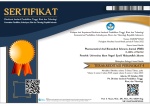Penambatan Molekul Senyawa Swietemacrophyllanin dari Kulit Batang Mahoni (Swietenia macrophylla King,) sebagai Inhibitor Enzim Alfa Glukosidase
Abstract
Keywords
References
Alberti KGMM (2010). Textbook of Diabetes. Fourth Edi. (Holt RI., Cockram CS, Elyvbjreg A, Goldstein BJ, eds.). Wiley-Blackwell.
Bakar NFA, Bakeri NA, Salleh LM, et al. (2020) Extraction of Swietenia macrophylla seed oil using supercritical carbon dioxide technique and its antioxidant, antidiabetic and toxicity properties. Chem Eng Trans. 78:523-528.
Chaudhary KK, Mishra N. A (2016). Review on Molecular Docking: Novel Tool for Drug Discovery. JSM Chem. 4(3):1029.
Dipiro J, Talbert RL, Yee GC, et al. (2015). Pharmacoterapy A Phatophysiologic Approach.
Falah S, Safithri M, Katayama T, et al. (2010). Hypoglycemic Effect of Mahogany (Swietenia macrophylla King.) Bark Extracts in Alloxan-induced Diabetic Rats. Wood Res J.1(2):89-94.
Falah S, Suzuki T, Katayama T. (2012). Chemical constituents from S.macrophylla bark and their antioxidant activity. Pakistan J Biol Sci. 11(16):2007-2012
Fasciotti M, Alberici RM, Cabrai EC, et al. (2013). Wood Chemotaxonomy via ESI-MS profiles of phytochemical markers: The challenging case of African versus Brazilian Mahogany woods. AIChE Annual Meet Conf Proc. Published online.
Garcia UG, Benito-Vicente A, Jebari S, et al. (2020). Pathophysiology of type 2 diabetes mellitus. Int J Mol Sci. 21(17):1-34.
Hashim MA, Yam MF, Hor SY, et al. (2013). Anti-hyperglycaemic activity of Swietenia macrophylla king (Meliaceae) seed extracts in normoglycaemic rats undergoing glucose tolerance tests. Chinese Med (United Kingdom). 8(1):1-8.
Kemenkes RI (2020). Tetap produktif, cegah dan atasi diabetes mellitus. Pusat data dan Informasi kementrian Kesehatan RI. Published online.
Khaerunnisa A. Djamil R, Sulastri S dkk. (2022). Aktivitas Fraksi Air Kulit Batang Mahoni (Swietenia macrophylla King.) dan Studi In silico Senyawa Kimia Penghambat Enzim α-Glukosidase). Jurnal Fitofarmaka Indonesia. 9(1): 6-14.
Lin BD, Zhang CR, Yang SP, et al. (2011). Phragmalin-type limonoid orthoesters from the twigs of Swietenia macrophylla. Chem Pharm Bull. 59(4):458-465.
Mousa OM, Issa MY, El-Askary HI, et al., (2014).Lipoidal composition and bioactivity of leaves and barks of Swietenia mahogani and Swietenia macrophylla grown in Egypt. 3(4):187-212.
Perera WH. Shivanagoudra SR. Perez JL et al. (2021). Anti-inflammatory, antidiabetic properties and in silico modeling of cucurbitane-type triterpene glycosides from fruits of an Indian cultivar of Momordica charantia L. Molecules. 26(1038): 2-18.
Rachmatiah T, Permatasari D, Dewi T, et al., (2015). Potensi antidiabetes pada daun, kulit batang dan biji mahoni (Swietenia macrophylla King). Sainstech. 25(2):88-91.
Ramadhan R, Phuwapraisirisan P, Kusuma IW, Amirta R. (2020). Ethnopharmacological evaluation of selected east kalimantan flora for diabetes therapy: The isolation of lupane triterpenoids as α-glucosidase inhibitors from ceriops tagal (perr) c.b.robb. Rasayan J Chem. 13(3):1727-1734.
Rammohan A, Bhaskar BV, Venkateswarlu N, et al. (2020). Design, synthesis, docking and biological evaluation of chalcones as promising antidiabetic agents. Bioorg Chem. 95(August 2019):103527.
Sari BL, Mun’Im A, Yanuar A, et al.. (2016). Screening of α-glucosidase inhibitors from Terminalia catappa L. Fruits using molecular docking method and in vitro test. Int J Pharm Pharm Sci. 8(12):184-189.
Tian L, Teng X, Zhong C, et al. (2015). Chemical Constituents from the Barks of Swietenia macrophylla. Gen Chem. 1(1):22-25.
World Health Organization (2016). Global Report on Diabetes. Publication on the World Health Organization.
DOI: 10.15408/pbsj.v5i2.32926
Refbacks
- There are currently no refbacks.






